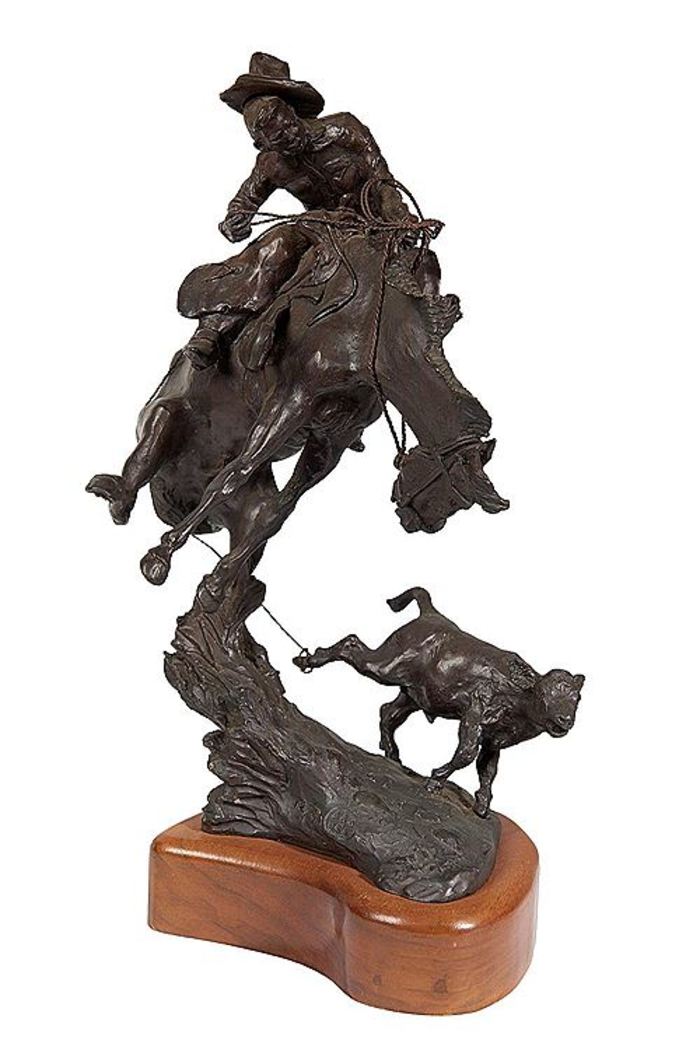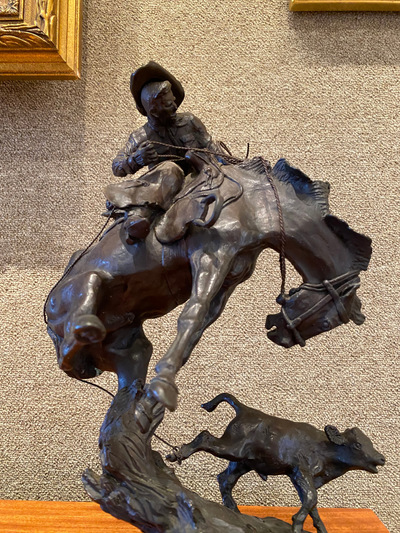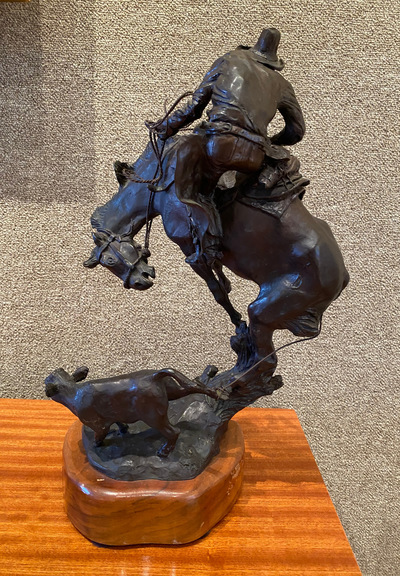An artist of "Old West" subject matter, William Moyers was both a painter and sculptor with a strong illustration background.
He was born in Atlanta, Georgia and learned as a youngster to break broncos and mend fences on a Colorado Ranch. He was educated at Adams State College and paid for his education by working on hay crews and breaking horses and then spent another year in art studies at the Otis Art Institute of Los Angeles.
He worked as an animation artist for Walt Disney Studios in California, followed by a decade of successful illustrating of western classics for national publications. In the 1960s, he devoted himself to his own art, which was detailed accurate, and inspiring works that capture the West.
He was a member and three-time president of the Cowboy Artists of America and lived in Albuquerque, New Mexico. His sons, Charles and John Moyers, and daughter-in-law Terri are all accomplished artists.
William Moyers died on Monday, May 3, 2010.

The following biography has been provided by Linda Sherer, owner of The Taos Gallery.
A member of the Cowboy Artists of America since 1968 and now a member Emeritus, Bill Moyers is a painter and sculptor of western subjects. His work is in numerous major collections including the Gilcrease Institute in Tulsa, Oklahoma; the National Cowboy Hall of Fame; the Albuquerque Museum; and the Cowboy Artists of America at Kerrville. He has won numerous gold and silver medals and is in prestigious publications including "Cowboy in Art" by Harmsen and "Bronzes of the American West," by Patricia Broder.
He and his wife Neva, who have been married fifty years, live in their home in Albuquerque surrounded by the artifacts of their long life together. At the age of fourteen, Bill came to Colorado with his father, a lawyer, who placed him with a family of five boys on a ranch. He worked his way through high school and college as a cowboy and began selling pictures of bucking horses for 25 cents each.
In 1939, he graduated with a degree in fine arts from Adams State Teachers College in Alamosa and later studied at the Otis Art Institute in Los Angeles with E. Roscoe Shraeder, a pupil of illustrator Howard Pyle. To earn extra money, he worked at Walt Disney Studios for a year on the movie "Fantasia."
In 1943, he and Neva married, and he served in the Army and she in the Navy, and they lived in New York City where he began illustration, winning an "American Artist" magazine competition for illustrating an Owen Wister novel. From that time, his career took off, and Neva handled the business side but stayed in the Navy until his success was obvious. The couple lived in Atlanta, Georgia where he did over 200 illustration assignments, and they had four children, two of whom are artists--John Moyers, also a member of the Cowboy Artists of America, and Charles, a sculptor.
On a summer visit to Taos in 1958, the Moyers met Tom and Sally Lewis, owners of The Taos Gallery, and they asked Bill to do paintings for their gallery. It was the beginning of a long association, which continues to this day, and to facilitate the relationship, the Moyers moved to Albuquerque in 1962. Until 1978, the time when Tom Lewis died, he handled every piece of Moyers' work beginning with painting and later sculpture. Since 1966, Bill estimates he has created more than fifty bronzes.
His work is highly realistic combined with emotional involvement with the subject and is in the tradition of Charles Russell and Frederic Remington. Moyers regards his art as an extension of human experience: "The basic elements of fear, conflict, hunger, need, and the effects of weather . . .anyone in the world during any age can understand (New Mexico Magazine, June 1993).

William Moyers
Painter and sculptor of objective scenes in Western life, born in Atlanta, Georgia in 1916 and living in Albuquerque, New Mexico. "I paint what I do," Moyers observes, "because I find the working cowboy, past and present, such a harmonious outgrowth of his whole environment. He accepts the action, weather, loneliness, and responsibilities as a normal existence. Too, there is a lot of nostalgia in it for me—a chance to recapture something of which I can no longer be a part.
"When I was fourteen," he adds, "I had the fortune to come to the San Luis Valley of Colorado for a summer on a ranch. I did not return to Georgia for five years, and then just for two months." Before long, his competence as a cowboy helped pay his tuition at Adams State College where he graduated in 1939. He also studied at Otis Art Institute in Los Angeles before getting a job with Walk Disney Studios that showed him that "competent art could be produced on regular hours." He taught school in Colorado and then served in the Army in World War II. For the next fifteen years, he worked as an illustrator in New York City.
"By about 1962, Western art mushroomed," he recalls, "and I started putting all my time into that, but I'm no missionary. The West is a real part of my life." He became a member of the Cowboy Artists of America in 1968 and won the gold medal for sculpture three times by 1975. At the CA show in 1981, his oil "Clearing the High Country," sold for $8,000 and his bronze "The Warming Cup" for $5,000. He is listed in Who's Who in American Art, was featured in Southwest Art, March 1980.
Resource: Contemporary Western Artists, by Peggy and Harold Samuels 1982, Judd's Inc., Washington, D.C.




